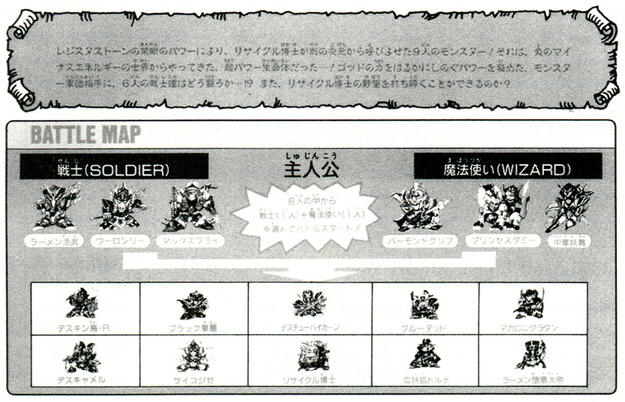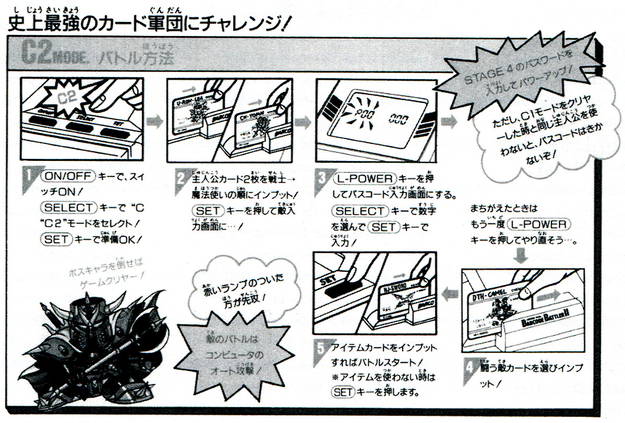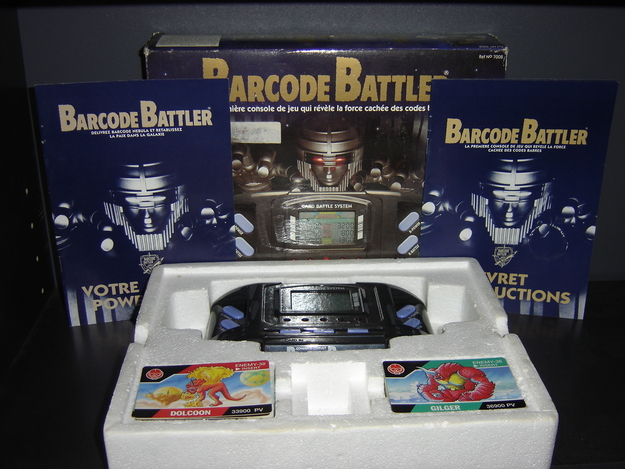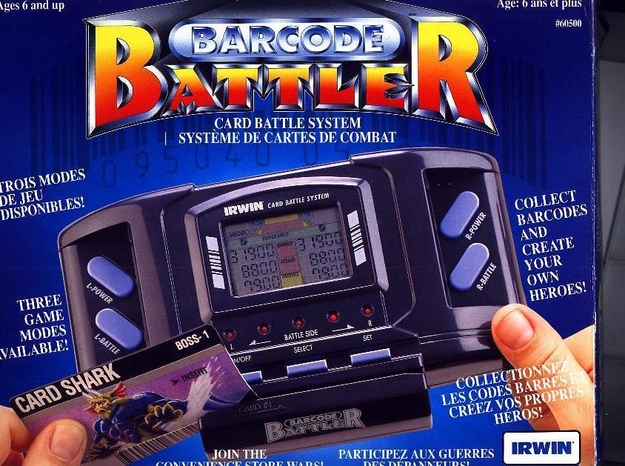The 'Poltergeist' generation of video game freaks, lost in a dead zone, staring at a flickering crt, is fading fast. In their place is the next incarnation; kids coming back into orbit, dissatisfied with going up against the circuit designer, or programmer's skill to get their buzz.
This new world is of contests between wetware warriors, donning analog armour to wage war in a video game battleground. They become masters, and compete in major national tournaments - special Olympics for the socially inept, but digitally awesome.
Conveni Wars - Barcode Battler - published in Mediamatic Magazine Vol. 7#2 (1993)
But even as these kids find their footing, their playing field has sprung a leak... the very plates of their continents are shifting and lava is spewing out into their 'other' world. The surprise is that the new playing field is real, a product of industry... The magnetic field on which they now surf entangles past and present in a world of infospatial and image-historical referents. They're consuming data resources faster than game manufacturers can produce them, so to find their way into new, exciting surf-turf, they need mapping devices. As with Geiger counters and Global Positioning Systems, they're using the Barcode Battler to re-survey the world back from an invisible commercial info-map.
Conveni Wars - Barcode Battler - published in Mediamatic Magazine Vol. 7#2 (1993)
Conveni-Wars
The first Barcode Battler came out in March of 1991. It looked innocent enough. Manufactured by Epoch Co., Ltd., the package included a GameBoy-type, fits-in-your-pocket bundled software machine, with the important difference that there are no character traits written into icons on their screens. The machine comes equipped with two barcode reading slots, one at either end, and ten player cards - eight with barcodes printed on them, and two without.
One icon appears on the screen for each player, but to bring them to life, you have to read in barcodes. The lower six of the 13 bars are used to scan in parameters for 'life force', 'offensive', and 'defensive' strength. The cards that come with the machine have cartoon images, and names like Mineral Water Maiden and Potato Chip Warrior, figures whose costumes are thinly disguised copies of their various products' labels.
The barcodes on these cards correspond to real products. The two character cards without barcodes have generic, pseudo-medieval costumes and empty spaces where the barcodes belong. Since the key to competitiveness is all in the barcode, its a pretty short path between playing out all the possible variations of the given cards, and going on a rampage through the house, cutting barcodes out of anything that you can find, inputting, and contesting them.
After a few contests between Marlboro and Nacho Cheese Doritos, they realize the Marlboro man's dark secret: he can't get it up. He's weak where it counts. No longer will they see his commercials and see a tough loner. He smokes too much because he's got something to hide. They begin seeing the world through a new set of eyes. The name of the software they're playing? Conveni-Wars.
Terminals
Conveni is a Japanese abbreviation for the English words 'convenience store'. War is, well, hell... but somebody's got to do it. The assumption behind the game is that convenience stores are not what they seem. They look, to the uneducated eye, like terminals, in the sense of point-of-sale consumption points at the end of very large distribution chains for processed goods. The far end of the automated factory and distribution mainframes.
All of the items for sale there are basically made or broken in the world of advertising. Re-surveyed by the Barcode Battler, convenience stores are in fact terminals in the sense of airports into mysterious adventure lands, rich lands, sitting on massive information reservoirs, ripe to be harnessed.
The Barcode Battler just managed to articulate something that a lot of people have guessed all along: there is a verifiable way to prove that the 'force' is with Pepsi, and not with Coke. Fights between who chooses what to watch on late night tv are easily settled: pit Dynasty against Green Acres, and see if Zsa Zsa Gabor, as Alexis, can trounce those poor bumpkin farmers as well as she does Hollywood policemen!
The Japanese game magazine Famicon Tsushin'''s September issue goes so far as to call 7-11 the barcode kids' Jerusalem. I think they've got a point. All of these nights they've been there, reading magazines and comic books for hours at a time, waiting for a sign. The Barcode Battler'' delivered.
New Values
Barcodes are secret keys which re-inform the convenience store, re-surveying the land according to the map, moving mountains according to a different ruler. The Barcode Battler re-configures a new landscape according to the product's barcode strength, and its advertised/packaged image. Codes are also a tie-up heaven for advertisers to create an entire new world of values. (It's even beginning to be used on television game shows... people need no longer test their skills against each other, the prizes themselves battle it out for the contestants!) A tool to get people to go out and scavenge for a certain number sequence. Barcode kids are out there, today, in the stores crying at their mothers to buy Brand x cereal because It's a matter of life and death, mom! and really meaning it.
Are the numbers that form the map's coordinates random? No. The first 2 digits of a bar code are the country of the product's origin. The next 5 are the manufacturer's code, followed by 5 for the product's item code, and the last 1 is a stop bit, to check the accuracy of the reading mechanism. Information vital, and specific to that given product's commercialisation.
The only thing not encoded is their mythology, something supplied by advertising. These are low resolution games. You need to imagine the battle, even as you fight it. Having a strong barcode is like having a magic sword, an Excalibor. These barcode kids are proving that there is a literacy, a topography there.
Within the course of the game, through their emotional engagement and identification with the fates of these 'character' identifiers, a reference point is created, a win/loss, 0/1 coordinate generated from which they can see further into the world that has existed and to which bar codes provided the key.
The landscape there doesn't change. A weak Marlboro yesterday will still be a weak Marlboro today, unless its manufacturer, distributor or product category change. The dimension of advertising imagery, as tied to these specific bar code numbers, helps breathe unexpected twists, and 'life' into the discoveries of their strengths, weaknesses and fates.
The Real Warrior
There's the potential to uncover legends, histories, which shift according to changes in manufacturing and distribution. Codes chart the rise and fall of great empires. Among barcode kids, some convenience stores are even said to be more powerful than others. They go there initially, of course, just looking for stronger barcodes, in terms of real products, from 'chocolate kingdoms' or 'tobacco tribes', but in the process, they're discovering the real warrior: distribution and manufacturing chain factions, and a cohesive method of mapping them.
In a world where products continue to shift from those to be consumed (gum), to those to be traded (baseball cards with gum), when the goods' exchange value are more important than their 'use' value, a body needs a map. Unlike the video game warriors, or vr 'heads' who play at karate, or composing jazz on a bananafish trombone, there is very little virtual about the coordinates of their game world. They're mapping a world which is none the less real, for being invisible to the eye.

